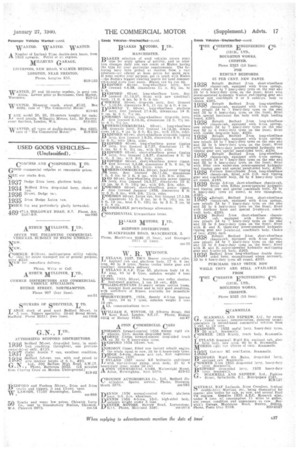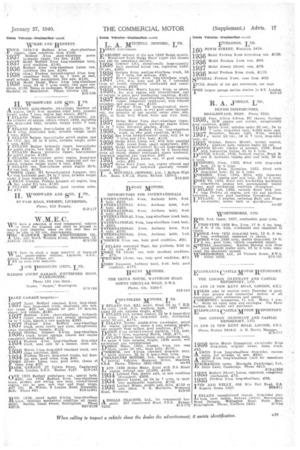A.E.C.s Put Up Big Mileages, on, Bus Service in South
Page 39

Page 40

Page 41

If you've noticed an error in this article please click here to report it so we can fix it.
Africa ALWAYS enterprising operators of A.h.C.s in South Africa, the Johnston, Bus Service of Germiston purchased their first Regal bus in 1932 and, with the exception of one or two small types, this and other A.E.C. models have been used. ever since.
Founded by Mr. D. A. Johnston, who sailed for South Africa in 1926, the firm maintain regular passenger services between Germiston and Johannesburg, principally with A.E.C.s. Six of these vehicles are now in regular commission, of which four are powered by oil units and two by petrol
engines. All the vehicles are hard worked ; the first bus is on the road before 5 a.m. and the last does not return to the garage until 12.30 a.m. Between these times they maintain a 45-minute service over a route 11 miles long.
Big mileages are achieyed, and four Q-type machines are now each travelling over 100,000 miles per annum The first Regal, with well over 500,000 miles of trouble-free running to its credit, has just been provided with a new body and, after a complete overhaul, is now embarking upon another span of intensive services.
With such mileages as this, great attention is paid to maintenance and, in this case, the unit-exchange system is followed. With a spare engine, gearbox and differential, it is rare for any vehicle to be off the road for more than a few hours. Greasing (every 24 hours) is carried out by native labour awl for fleet maintenance four mechanics and two fourth-year apprentices are employed. The staff is large in proportion to the size of the fleet, principally because colonial road conditions call for the frequent replacement of springs, shackle-pins and bushes.
Oil engines are usually removed after 50,000 miles and petrol units after 60,000 miles. Every engine removed is stripped down, so that all parts may
be properly cleaned and thoronghly examined.Oilers at the second stripping (100,000 miles) are rebored. or sleeved.
Engine sumps are drained, every 4,000.... miles, ., gearboxes eyery §,000 miles and differentials _ abOut once 4 week. In the last-named case, the oil is used for greasing purposes. Under the system in operation, each bus spends one morning in the garage every 14 days.
• The reliability of the vehicles themselves and the effectiveness of the maintenance system employed are demonstrated by the fact that, despite the difficulties of operation, the firm's breakdown figure now-Stands at one involuntary stop for every 50,000 miles running.
All the staff employed by the coinpany-a.re specially picked men, high pay and short hours being characteristics Of their employment. Drivers' wages are £7 for a 48-hoffr week; mechanics earn 5s. per 45-hour working week, without night duty or overtime. Privileges include free milk and fruit refreshments twice .daily, a Saturday morning off per month, rent rebates for living near the depot and frequent public holidays off on full pay when work is in advance. All the staff are given, annually, a fortnight's holiday with full pay.
12 YEARS' TEA-ESTATE WORK UNDER DIFFICULTIES.
ANUMBER of Guy vehicles is operating in remote parts of the world, often far from even the most primitive kind of service station, and, in some cases, under conditions . for which there is no parallel in this country-. A 3-5-ton rigid six-wheeler in use in Matelli, Dooars, represents a good example. It arrived at Matelli on July 26, 1927, and has been in con
tintious service ever since. It has been used for carrying heavy loads between the Chulsea tea estates and the nearest station, over roads which, even now they are metalled, do not compare with the worst roads in this country. For the first eight years of the vehicle's life the routes were merely tracks with loose surfaces.
In a report on the performance and condition of this vehicle, written to his head 'office 11 years after it was delivered, the resident manager of the estate said that the engine, gearbox, axles and springs were the originals, and that little had been spent on repairs considering the time the vehicle had been in use After 10 years of service the vehicle was stripped and overhauled, when the transmission needed a few replacements.
SCAMMELL MECHANICAL HORSE ACHIEVES SUCCESS OVERSEAS.
INTERESTING news comes to hand from three different corners of the world—Malta, Jamaica and Rangoon— of the solution of special transport problems by the Scammell mechanical horse. A 3-tonner with a special insulated milk carrier has been supplied to the Malta Public Works Department for the conveyance of milk in churns from the mountains, where the goats are herded and milked, to the towns where it is retailed. Coats were previouslv milked in the streets when and
where the purchasers required—a picturesque system, hut less hygienic than that now in operation.
The same department has purchased seven 15 h.p, 3-ton mechanical horses to be employed with the well-known Scammell 12-cubic;yd. moving-floor refuse Collector.
Rangoon Meat Marketing Board has purchased a fleet of Scammell vehicles for the conveyance of meat, the machines being also employed for other municipal duties.
In Jamaica, the West Indies Sugar Co. is operating a fleet of six• 6-ton mechanical horses with ordinary flat • platform trailers and with hydraulic tippers. The transport problems of • this company are not simple. They call for vehicles for collecting sugar cane in the fields,., delivering it to the factory for refining purposes, then taking 'the semi-refined sugar to the docks for shipment, besides the conveyance of manure to the fields and other agricultural purposes.
Because oil fnel costs 4d, per gallon on the island, against is. 6d. pet' gallon for petrol, the mechanical horses are fitted with Perkins oil engines. As the ground is extremely rough, when • the mechanical horses take the trailers to the canefields they disconnect and a special attachment is fitted to the trailer—rather on the same principle as horse-shafts--the actual work in the fields being done by oxen.
This fleet of Scammell units has been running in Jamaica for about a year, and in spite of heat and rough roads the machines are working very satisfactorily.
THORNYCROFTS ACCOMPLISH DIFFICULT TASK IN NIGERIA.
A MONGST the most difficult tasks 1-1.overseas which have recently been successfully entrusted to Thornycroft vehicles is the transport of heavy pieces of machinery in connection with the construction of a new power house in Nigeria, by the Nigerian Electricity Supply Corporation, Ltd.. For this undertaking two specially constructed Trusty 8-ton 85 b.h.p. oil-engined vehicles, together with a Crane 15-ton low-loading trailer, equipped with giant
single• low-pressure tyres, were utilized to cOnvey, in sections i a large alternator from KUru Station to Jekko Camp in the interior. An accompanying picture shows one of these -Thornycrofts, with trailer attached, manned by a European driver and two native attendants and negotiating one cif the more difficult parts of the dirt road.
The many acute bends and steep gradients which it was essential to-overcome on this speeially made track resulted, on several occasions, „in-one or other of the vehicles being ditched. Nevertheless, the loads were safely conveyed to the site without damage to the lorries, or accident to the personnel.
Amongst other difficult loads which -were successfully handled was a 50-ft. 'dredger .arm, which was •conveyed over the same route. On the return journeys these vehicles are carrying tin _ore in bags.
Each vehicle is equipped with a double-roof cab and -fully opening windscreen, 'which .provide additional ,cooling and comfort for the driver during the very hot weather Which prevails during the summer months.
,BEDFORDS USED FOR MONOPOLY SYSTEM IN SOUTHERN INDIA.
WS operation has been set up on a sound basis in Southern India by the •establiShment.of monopoly for 10 companies -merging more than 60 owners. As a result, 'U.M.S. (United' Motor SerViee) now operate a fleet numbering more than :200 vehicles, most of which are Bedfords. As those of other makes aretaken out of 'service they are, we understand, replaced
by new Bedfords. '
Starting with one bus which he-drove
'himself,in order . to gain. practical :experience, the organizer behind the 1.1.M.S., Mr. G. D. Naidu, has proved that, with efficient management. and
the right vehicles, a thriving traiispoti service can be built up in spite of economic and local difficulties.
Mr. Naidu has applied first-hand knowledge of bus operation in other countries to the organization of the -services in his charge, with the result that U.M.S. operate under the most efficient western methods, a good range of modern equipment being employed for the expeditious maintenance of vehicles.
The working capacity of the service stations which have -been established is approximately 180 complete over hauls per annum. Bodybuilding is carried out within the organization, with a production capacity of about 100 bodies per year. The painting. equipment can deal With 34 buses per day, the number of operators required being only six.
Some of the bus bodies are of a design similar to the familiar " toastracks" of seaside resorts., whilst others resemble modern service buses, but have open sides. All of them have a substantially -built roof with deep luggage rails, for when the Indian native travels .he needs much space for his baggage.
1;000=MILE DESERT SURVEY BY ALION OILERS.
TWO Albion vehicles recently delivered to the Public Works Department of the Bechuanaland:Protectorate .Governtnent were engaged during September and October of last year on a remarkable survey trip across the Kalahari Desert. The Vehicles, of the Model 126 type, were equipped' With oil engines, special 44-gallon Mel tanks, and single low-pressure tyres. Much of the country traversed is -dotted With scrub and bush, to deal with which a stout front bumper was fitted to each machine to enable these obstructions to be brushed aside. In addition, each machine vat equipped with a' stout detaehable radiator guard to -prevent -the radiator from being damaged through contact with trees, etc.
Roads were, of course, completely non-existent and all types of surface were met with. The vehicles traversed just over 1,000 miles in six weeks, almost 90 per cent, of the work being performed in country where no road vehicle had previously ventured. A compass course was set and rigidly adhered to, necessitating the vehicles crossing dried-up river beds, soft sand and light and dense bush.
The sturdy construction of the machines is well exemplified by the fact , that the only mechanical trouble experienced on the whole journey was due to a branch from a tree tearing away the oil-fuel pipe line on one of the vehicles.
Certain of the days' runs were little more than five miles due to the extremely soft and sandy nature of the soil, necessitating laying down canvas sheets in front of the vehicles to surmount the difficulty. It is, therefore, not surprising that the rate of fuel consumption fell, on one occasion, to 6 m.p.g., but the average throughout the whole trip was in the region of 12 m.p.g. During the course of the trip one of the machines fell into an open bole 4-ft. deep, but fortunately suffered no damage.
Altogether the whole trip constitutes a remarkable performance for ions'wheeled vehicles of normal construction.




















































































